Decoding the Role of Interface Engineering in Energy Transfer: Pathways to Enhanced Efficiency and Stability in Quasi-2D Perovskite Light-Emitting Diodes
Abstract
1. Introduction
2. Fundamental Properties of Quasi-2D Perovskite Materials
2.1. Structural and Compositional Features
2.2. Carrier Recombination Dynamics and PLQY Optimization
2.3. Energy Funneling Mechanisms
3. Energy Transfer Strategies in Quasi-2D PeLEDs
3.1. Intra-Material Energy Funneling: Phase and Additive Engineering
3.1.1. Phase Composition and Distribution Control
3.1.2. Additive Engineering for Defect Passivation
3.2. Device-Level Interfacial Engineering: Charge Injection and Energy-Level Alignment
3.2.1. Bottom Interface Optimization
3.2.2. Top Interface Optimization
3.2.3. Dual-Interface Modulation: Insulator–Perovskite–Insulator (IPI) Structures
3.3. Supplementary Strategies for Enhanced Performance
3.3.1. Carrier Management
3.3.2. Photon Management
3.3.3. Stability Enhancement

4. Challenges in Energy Transfer Research for Quasi-2D PeLEDs
4.1. Spectral Stability in Blue Emission
4.2. Efficiency Roll-Off at High Current Densities
4.3. Operational Stability and Degradation Mechanisms
4.4. Scalable Fabrication and Commercialization
5. Conclusions and Perspectives
5.1. Material Innovation and Design
5.2. Device Architecture and Scalability
5.3. Mechanistic Insights and Stability
5.4. Eco-Friendly PeLEDs
5.5. Machine Learning to Improve PeLED Performance
Author Contributions
Funding
Data Availability Statement
Conflicts of Interest
References
- Forgács, D.; Gil-Escrig, L.; Pérez-Del-Rey, D.; Momblona, C.; Werner, J.; Niesen, B.; Ballif, C.; Sessolo, M.; Bolink, H.J. Efficient Monolithic Perovskite/Perovskite Tandem Solar Cells. Adv. Energy Mater. 2017, 7, 1602121. [Google Scholar] [CrossRef]
- Hu, Y.; Schlipf, J.; Wussler, M.; Petrus, M.L.; Jaegermann, W.; Bein, T.; Müller-Buschbaum, P.; Docampo, P. Hybrid Perovskite/Perovskite Heterojunction Solar Cells. ACS Nano 2016, 10, 5999–6007. [Google Scholar] [CrossRef] [PubMed]
- Zhang, L.; Sun, C.; He, T.; Jiang, Y.; Wei, J.; Huang, Y.; Yuan, M. High-performance quasi-2D perovskite light-emitting diodes: From materials to devices. Light Sci. Appl. 2021, 10, 61. [Google Scholar] [CrossRef] [PubMed]
- Jamaludin, N.F.; Yantara, N.; Giovanni, D.; Febriansyah, B.; Tay, Y.B.; Salim, T.; Sum, T.C.; Mhaisalkar, S.; Mathews, N. White Electroluminescence from Perovskite–Organic Heterojunction. ACS Energy Lett. 2020, 5, 2690–2697. [Google Scholar] [CrossRef]
- Yuan, F.; Ran, C.; Zhang, L.; Dong, H.; Jiao, B.; Hou, X.; Li, J.; Wu, Z. A Cocktail of Multiple Cations in Inorganic Halide Perovskite toward Efficient and Highly Stable Blue Light-Emitting Diodes. ACS Energy Lett. 2020, 5, 1062–1069. [Google Scholar] [CrossRef]
- Smith, M.D.; Connor, B.A.; Karunadasa, H.I. Tuning the Luminescence of Layered Halide Perovskites. Chem. Rev. 2019, 119, 3104–3139. [Google Scholar] [CrossRef]
- Meng, F.; Liu, X.; Chen, Y.; Cai, X.; Li, M.; Shi, T.; Chen, Z.; Chen, D.; Yip, H.-L.; Ramanan, C.; et al. Co-Interlayer Engineering toward Efficient Green Quasi-Two-Dimensional Perovskite Light-Emitting Diodes. Adv. Funct. Mater. 2020, 30, 1910167. [Google Scholar] [CrossRef]
- Zheng, Y.; Zheng, X.; Hu, H.; Guo, T. Microstructure and Luminescence Characteristics of CsPbBr3 Perovskite Films by Solution Process. Chin. J. Lumin. 2020, 41, 775–781. [Google Scholar] [CrossRef]
- Cao, Y.; Wang, N.; Tian, H.; Guo, J.; Wei, Y.; Chen, H.; Miao, Y.; Zou, W.; Pan, K.; He, Y.; et al. Perovskite light-emitting diodes based on spontaneously formed submicrometre-scale structures. Nature 2018, 562, 249–253. [Google Scholar] [CrossRef]
- Lin, K.; Xing, J.; Quan, L.N.; de Arquer, F.P.G.; Gong, X.; Lu, J.; Xie, L.; Zhao, W.; Zhang, D.; Yan, C.; et al. Perovskite light-emitting diodes with external quantum efficiency exceeding 20 per cent. Nature 2018, 562, 245–248. [Google Scholar] [CrossRef]
- Guo, H.; Shi, L.; Shi, Z.; He, Y.; Zhu, Y. Direct synthesis of high quantum yield lead-free CsCu2I3 powder in water and its application in yellow LED. Exploration 2025, 5, 20240004. [Google Scholar] [CrossRef] [PubMed]
- Bao, X.; Gao, Y.; Liu, Y.; Xu, Z.; Zhang, F.; Lu, M.; Wu, Z.; Wu, Y.; Wang, Q.; Zhang, Y.; et al. Molecular Bridging Strategy Enables High Performance and Stable Quasi-2D Perovskite Light-Emitting Devices. ACS Energy Lett. 2023, 8, 1018–1025. [Google Scholar] [CrossRef]
- Cheng, L.; Cao, Y.; Ge, R.; Wei, Y.-Q.; Wang, N.-N.; Wang, J.-P.; Huang, W. Sky-blue perovskite light-emitting diodes based on quasi-two-dimensional layered perovskites. Chin. Chem. Lett. 2017, 28, 29–31. [Google Scholar] [CrossRef]
- Ye, D.; Li, Z.; Chen, W.; Ighodalo, K.O.; Xiao, P.; Chen, T.; Xiao, Z. Stable Yellow Light-Emitting Diodes Based on Quasi-Two-Dimensional Perovskites. ACS Appl. Mater. Interfaces 2022, 14, 34918–34925. [Google Scholar] [CrossRef]
- Huang, S.; Huang, P.; Wang, L.; Han, J.; Chen, Y.; Zhong, H. Halogenated-Methylammonium Based 3D Halide Perovskites. Adv. Mater. 2019, 31, 1903830. [Google Scholar] [CrossRef]
- Ramadan, A.J.; Jeong, W.H.; Oliver, R.D.J.; Jiang, J.; Dasgupta, A.; Yuan, Z.; Smith, J.; Lee, J.E.; Motti, S.G.; Gough, O.; et al. The Role of the Organic Cation in Developing Efficient Green Perovskite LEDs Based on Quasi-2D Perovskite Heterostructures. Adv. Funct. Mater. 2024, 34, 2309653. [Google Scholar] [CrossRef]
- Lee, J.-W.; Park, N.-G. Quasi-two-dimensional perovskite light emitting diodes for bright future. Light Sci. Appl. 2021, 10, 86. [Google Scholar] [CrossRef]
- Zhang, D.; Chao, L.; Jin, G.; Xing, Z.; Hong, W.; Chen, Y.; Wang, L.; Chen, J.; Ma, D. Highly Efficient Red Perovskite Light-Emitting Diodes with Reduced Efficiency Roll-Off Enabled by Manipulating Crystallization of Quasi-2D Perovskites. Adv. Funct. Mater. 2022, 32, 2205707. [Google Scholar] [CrossRef]
- Bae, Y.; Ryu, J.; Yoon, S.; Kang, D.-W. Recent progress in quasi-two-dimensional and quantum dot perovskite light-emitting diodes harnessing the diverse effects of ligands: A review. Nano Res. 2022, 15, 6449–6465. [Google Scholar] [CrossRef]
- Chen, H.; Pina, J.M.; Hou, Y.; Sargent, E.H. Synthesis, Applications, and Prospects of Quantum-Dot-in-Perovskite Solids. Adv. Energy Mater. 2022, 12, 2100774. [Google Scholar] [CrossRef]
- Dong, Y.; Wang, Y.-K.; Yuan, F.; Johnston, A.; Liu, Y.; Ma, D.; Choi, M.-J.; Chen, B.; Chekini, M.; Baek, S.-W.; et al. Bipolar-shell resurfacing for blue LEDs based on strongly confined perovskite quantum dots. Nat. Nanotechnol. 2020, 15, 668–674. [Google Scholar] [CrossRef] [PubMed]
- Kim, Y.-H.; Kim, S.; Kakekhani, A.; Park, J.; Park, J.; Lee, Y.-H.; Xu, H.; Nagane, S.; Wexler, R.B.; Kim, D.-H.; et al. Comprehensive defect suppression in perovskite nanocrystals for high-efficiency light-emitting diodes. Nat. Photonics 2021, 15, 148–155. [Google Scholar] [CrossRef]
- Chu, Z.; Ye, Q.; Zhao, Y.; Ma, F.; Yin, Z.; Zhang, X.; You, J. Perovskite Light-Emitting Diodes with External Quantum Efficiency Exceeding 22% via Small-Molecule Passivation. Adv. Mater. 2021, 33, 2007169. [Google Scholar] [CrossRef]
- Liu, Z.; Qiu, W.; Peng, X.; Sun, G.; Liu, X.; Liu, D.; Li, Z.; He, F.; Shen, C.; Gu, Q.; et al. Perovskite Light-Emitting Diodes with EQE Exceeding 28% through a Synergetic Dual-Additive Strategy for Defect Passivation and Nanostructure Regulation. Adv. Mater. 2021, 33, 2103268. [Google Scholar] [CrossRef]
- Yuan, S.; Dai, L.; Sun, Y.; Auras, F.; Zhou, Y.-H.; An, R.-Z.; Liu, Y.; Ding, C.; Cassidy, C.; Tang, X.; et al. Efficient blue electroluminescence from reduced-dimensional perovskites. Nat. Photonics 2024, 18, 425–431. [Google Scholar] [CrossRef]
- Nong, Y.; Yao, J.; Li, J.; Xu, L.; Yang, Z.; Li, C.; Song, J. Boosting External Quantum Efficiency of Blue Perovskite QLEDs Exceeding 23% by Trifluoroacetate Passivation and Mixed Hole Transportation Design. Adv. Mater. 2024, 36, 2402325. [Google Scholar] [CrossRef]
- Zhang, D.; Fu, Y.; Zhan, H.; Zhao, C.; Gao, X.; Qin, C.; Wang, L. Suppressing thermal quenching via defect passivation for efficient quasi-2D perovskite light-emitting diodes. Light Sci. Appl. 2022, 11, 69. [Google Scholar] [CrossRef]
- Ren, Z.; Wang, K.; Sun, X.W.; Choy, W.C.H. Strategies Toward Efficient Blue Perovskite Light-Emitting Diodes. Adv. Funct. Mater. 2021, 31, 2100516. [Google Scholar] [CrossRef]
- Li, B.-H.; Di, H.; Li, H.; Wang, J.-C.; Zeng, W.; Cheng, D.-B.; Zhou, C.; Wang, X.; Shi, Y.; Song, J.; et al. Unveiling the Intrinsic Photophysics in Quasi-Two-Dimensional Perovskites. J. Am. Chem. Soc. 2024, 146, 6974–6982. [Google Scholar] [CrossRef]
- Cui, M.; Qin, C.; Jiang, Y.; Zhang, S.; Sun, C.; Yuan, M.; Yang, Y.; Liu, Y. Tuning exciton dynamics by the dielectric confinement effect in quasi-two-dimensional perovskites. Photonics Res. 2024, 12, 563. [Google Scholar] [CrossRef]
- Gan, Z.; Cheng, Y.; Chen, W.; Loh, K.P.; Jia, B.; Wen, X. Photophysics of 2D Organic–Inorganic Hybrid Lead Halide Perovskites: Progress, Debates, and Challenges. Adv. Sci. 2021, 8, 2001843. [Google Scholar] [CrossRef] [PubMed]
- Kim, G.-Y.; Jung, C.-W.; Chin, S.-H.; Jeong, W.H.; Lee, B.R.; Kim, J.-H.; Lee, J.-W. Controlled phase distribution of quasi-2D perovskite enables improved electroluminescence. J. Phys. Energy 2024, 6, 035002. [Google Scholar] [CrossRef]
- Fu, Y.; Zhan, H.; Zhang, D.; Cheng, Y.; Wang, L.; Qin, C. Insight into Diphenyl Phosphine Oxygen-Based Molecular Additives as Defect Passivators toward Efficient Quasi-2D Perovskite Light-Emitting Diodes. ACS App. Mater. Interfaces 2023, 15, 10877–10884. [Google Scholar] [CrossRef] [PubMed]
- Fu, Y.; Zhang, D.; Zhan, H.; Zhao, C.; Cheng, Y.; Qin, C.; Wang, L. Engineering of Annealing and Surface Passivation toward Efficient and Stable Quasi-2D Perovskite Light-Emitting Diodes. J. Phys. Chem. Lett. 2021, 12, 11645–11651. [Google Scholar] [CrossRef]
- Chen, X.; Lu, H.; Li, Z.; Zhai, Y.; Ndione, P.F.; Berry, J.J.; Zhu, K.; Yang, Y.; Beard, M.C. Impact of Layer Thickness on the Charge Carrier and Spin Coherence Lifetime in Two-Dimensional Layered Perovskite Single Crystals. ACS Energy Lett. 2018, 3, 2273–2279. [Google Scholar] [CrossRef]
- Xing, G.; Wu, B.; Wu, X.; Li, M.; Du, B.; Wei, Q.; Guo, J.; Yeow, E.K.L.; Sum, T.C.; Huang, W. Transcending the slow bimolecular recombination in lead-halide perovskites for electroluminescence. Nat. Commun. 2017, 8, 14558. [Google Scholar] [CrossRef]
- Shen, Y.; Wang, J.-K.; Li, Y.-Q.; Shen, K.-C.; Su, Z.-H.; Chen, L.; Guo, M.-L.; Cai, X.-Y.; Xie, F.-M.; Qian, X.-Y.; et al. Interfacial “Anchoring Effect” Enables Efficient Large-Area Sky-Blue Perovskite Light-Emitting Diodes. Adv. Sci. 2021, 8, 2102213. [Google Scholar] [CrossRef]
- Yu, Z.; Shen, X.; Fan, X.; Jung, Y.-K.; Jeong, W.H.; Dasgupta, A.; Kober-Czerny, M.; Caprioglio, P.; Park, S.H.; Choi, H.; et al. Hydrogen Bond-Assisted Dual Passivation for Blue Perovskite Light-Emitting Diodes. ACS Energy Lett. 2023, 8, 4296–4303. [Google Scholar] [CrossRef]
- Li, P.; Wei, C.; Dong, H.; Zhan, Z.; Zhu, Y.; Hua, J.; Zhang, G.; Chen, C.; Chai, Y.; Wang, J.; et al. Efficient Quasi-Two-Dimensional Perovskite Light-Emitting Diodes Achieved through the Passivation of Multi-Fluorine Phosphate Molecules. Micromachines 2024, 15, 799. [Google Scholar] [CrossRef]
- Quan, L.N.; Zhao, Y.; García de Arquer, F.P.; Sabatini, R.; Walters, G.; Voznyy, O.; Comin, R.; Li, Y.; Fan, J.Z.; Tan, H.; et al. Tailoring the Energy Landscape in Quasi-2D Halide Perovskites Enables Efficient Green-Light Emission. Nano Lett. 2017, 17, 3701–3709. [Google Scholar] [CrossRef]
- Wang, W.; Li, Y.; Duan, Y.; Qiu, M.; An, H.; Peng, Z. Performance Enhancement of Perovskite Quantum Dot Light-Emitting Diodes via Management of Hole Injection. Micromachines 2022, 14, 11. [Google Scholar] [CrossRef] [PubMed]
- Zhao, L.; Astridge, D.D.; Gunnarsson, W.B.; Xu, Z.; Hong, J.; Scott, J.; Kacmoli, S.; Al Kurdi, K.; Barlow, S.; Marder, S.R.; et al. Thermal Properties of Polymer Hole-Transport Layers Influence the Efficiency Roll-off and Stability of Perovskite Light-Emitting Diodes. Nano Lett. 2023, 23, 4785–4792. [Google Scholar] [CrossRef] [PubMed]
- Lei, L.; Seyitliyev, D.; Stuard, S.; Mendes, J.; Dong, Q.; Fu, X.; Chen, Y.-A.; He, S.; Yi, X.; Zhu, L.; et al. Efficient Energy Funneling in Quasi-2D Perovskites: From Light Emission to Lasing. Adv. Mater. 2020, 32, 1906571. [Google Scholar] [CrossRef]
- Lee, J.; Xie, Z.; Wang, L.; Hou, J. Advancements in Interfacial Engineering for Perovskite Light-Emitting Diodes. Chem. Eur. J. 2024, 30, e202400372. [Google Scholar] [CrossRef]
- Guo, Z.; Liang, Y.; Ni, D.; Li, L.; Liu, S.; Zhang, Y.; Chen, Q.; Zhang, Q.; Wang, Q.; Zhou, H. Homogeneous Phase Distribution in Q-2D Perovskites via Co-Assembly of Spacer Cations for Efficient Light-Emitting Diodes. Adv. Mater. 2023, 35, 2302711. [Google Scholar] [CrossRef]
- Shen, C.; Fang, S.; Zhang, J.; Liang, X.; Su, C.; Qing, J.; Cai, W.; Luo, Y.; Yang, R.; Hou, L. High performance and stable pure-blue quasi-2D perovskite light-emitting diodes by multifunctional zwitterionic passivation engineering. Adv. Photonics 2024, 6, 026002. [Google Scholar] [CrossRef]
- Meng, F.; Yuan, G.; Zhong, G.; Qiu, L.; Li, B.; Sun, G.; Feng, Q.; Zeng, Q.; Chen, Z.; Zhu, W.; et al. High-performance sky-blue quasi-2D perovskite light-emitting diodes via synergistic defect passivation and phase narrowing strategies. Chem. Eng. J. 2024, 496, 154188. [Google Scholar] [CrossRef]
- Zhang, X.; Shi, L.; Bai, J.; Wang, F.; Jiang, M. Heterointerface engineering of perovskite defects and energetics for light-emitting diodes. Nano Res. 2022, 16, 5525–5532. [Google Scholar] [CrossRef]
- Zhao, Y.; Li, M.; Qin, X.; Yang, P.; Zhang, W.-H.; Wei, Z. Efficient Perovskite Light-Emitting Diodes by Buried Interface Modification with Triphenylphosphine Oxide. ACS App. Mater. Interfaces 2023, 15, 3644–3650. [Google Scholar] [CrossRef]
- Zhang, F.; Gao, Y.; Wang, D.; Lu, P.; Wang, X.; Lu, M.; Wu, Y.; Chen, P.; Hu, J.; Bai, X.; et al. Phase distribution management for high-efficiency and bright blue perovskite light-emitting diodes. Nano Energy 2024, 120, 109144. [Google Scholar] [CrossRef]
- Zhu, C.; Yuan, F.; Liu, X.; Li, J.; Dong, H.; Zhao, C.; Yan, L.; Xu, Y.; Dai, J.; Si, J.; et al. High Triplet Energy Level Molecule Enables Highly Efficient Sky-Blue Perovskite Light-Emitting Diodes. J. Phys. Chem. Lett. 2021, 12, 11723–11729. [Google Scholar] [CrossRef] [PubMed]
- Park, S.; Kim, J.; Kim, G.-M.; Park, J.; Lee, S.; Lee, D.C.; Kim, N.; Cho, B.-G.; Shin, B. Controlling the Phase Distribution of Single Bromide Quasi-2-Dimensional Perovskite Crystals via Solvent Engineering for Pure-Blue Light-Emitting Diodes. ACS App. Mater. Interfaces 2024, 16, 38395–38403. [Google Scholar] [CrossRef] [PubMed]
- Shi, Y.; Wu, W.; Dong, H.; Li, G.; Xi, K.; Divitini, G.; Ran, C.; Yuan, F.; Zhang, M.; Jiao, B.; et al. A Strategy for Architecture Design of Crystalline Perovskite Light-Emitting Diodes with High Performance. Adv. Mater. 2018, 30, 1800251. [Google Scholar] [CrossRef]
- Li, J.; Yu, Q.; Gan, L.; Chen, D.; Lu, B.; Ye, Z.; He, K. Perovskite light-emitting devices with a metal–insulator–semiconductor structure and carrier tunnelling. J. Mater. Chem. C 2017, 5, 7715–7719. [Google Scholar] [CrossRef]
- Yuan, F.; Xi, J.; Dong, H.; Xi, K.; Zhang, W.; Ran, C.; Jiao, B.; Hou, X.; Jen, A.K.-Y.; Wu, Z. All-Inorganic Hetero-Structured Cesium Tin Halide Perovskite Light-Emitting Diodes with Current Density Over 900 A cm−2 and Its Amplified Spontaneous Emission Behaviors. Phys. Status Solidi RRL 2018, 12, 1800090. [Google Scholar] [CrossRef]
- Wang, S.; Guo, Y.; Feng, D.; Chen, L.; Fang, Y.; Shen, H.; Du, Z. Bandgap tunable Zn1−xMgxO thin films as electron transport layers for high performance quantum dot light-emitting diodes. J. Mater. Chem. C 2017, 5, 4724–4730. [Google Scholar] [CrossRef]
- Chen, J.; Tang, Z.; Zhou, Y.; Zhang, T.; Qian, L.; Xiang, C. In-situ solution processed zinc Oxide as electron transport layer for High-performance perovskite Light-emitting diodes. Chem. Phys. Lett. 2023, 819, 140441. [Google Scholar] [CrossRef]
- Li, W.; Xu, Y.-X.; Wang, D.; Chen, F.; Chen, Z.-K. Inorganic perovskite light emitting diodes with ZnO as the electron transport layer by direct atomic layer deposition. Org. Electron. 2018, 57, 60–67. [Google Scholar] [CrossRef]
- Zhang, J.; Wang, H.; Cao, F.; Wang, S.; Wu, J.; Dou, Y.; Zhang, J.; Chen, J.; Zhao, D.; Yang, X. Efficient All-Solution-Processed Perovskite Light-Emitting Diodes Enabled by Small-Molecule Doped Electron Injection Layers. Adv. Opt. Mater. 2019, 8, 1900567. [Google Scholar] [CrossRef]
- Miao, Y.; Cheng, L.; Zou, W.; Gu, L.; Zhang, J.; Guo, Q.; Peng, Q.; Xu, M.; He, Y.; Zhang, S.; et al. Microcavity top-emission perovskite light-emitting diodes. Light Sci. Appl. 2020, 9, 89. [Google Scholar] [CrossRef]
- Mei, G.; Xiao, X.; Ahmad, S.; Lin, H.; Tan, Y.; Wang, K.; Sun, X.W.; Choy, W.C.H. Microcavity Design Upping Light Extraction Efficiency over 50% in High-Index Perovskite Light-Emitting Diodes. Adv. Opt. Mater. 2023, 11, 2300912. [Google Scholar] [CrossRef]
- Matsushima, T.; Nasu, R.; Takekuma, K.; Ishii, T.; Feng, Z.; Tang, X.; Nakamura, N.; Tumen-Ulzii, G.; Adachi, C. Efficient Perovskite Light-Emitting Diodes with a Siloxane-Blended Organic Hole Transport Layer. Adv. Photonics Res. 2022, 3, 2200003. [Google Scholar] [CrossRef]
- Ma, H.; Ahn, E.; Lee, D.; Kim, H.; Lee, K.; Lee, H.C.; Lee, S.; Ji, S.; Kim, K.; Ahn, H.; et al. Water-induced degradation mechanism of metal halide perovskite nanocrystals. Matter 2025, 8, 102083. [Google Scholar] [CrossRef]
- Zhang, L.; Yuan, F.; Xi, J.; Jiao, B.; Dong, H.; Li, J.; Wu, Z. Suppressing Ion Migration Enables Stable Perovskite Light-Emitting Diodes with All-Inorganic Strategy. Adv. Funct. Mater. 2020, 30, 2001834. [Google Scholar] [CrossRef]
- Park, C.B.; Shin, Y.S.; Yoon, Y.J.; Jang, H.; Son, J.G.; Kim, S.; An, N.G.; Kim, J.W.; Jun, Y.C.; Kim, G.-H.; et al. Suppression of halide migration and immobile ionic surface passivation for blue perovskite light-emitting diodes. J. Mater. Chem. C 2022, 10, 2060–2066. [Google Scholar] [CrossRef]
- Jiang, Y.; Qin, C.; Cui, M.; He, T.; Liu, K.; Huang, Y.; Luo, M.; Zhang, L.; Xu, H.; Li, S.; et al. Spectra stable blue perovskite light-emitting diodes. Nat. Commun. 2019, 10, 1868. [Google Scholar] [CrossRef]
- Gangishetty, M.K.; Hou, S.; Quan, Q.; Congreve, D.N. Reducing Architecture Limitations for Efficient Blue Perovskite Light-Emitting Diodes. Adv. Mater. 2018, 30, 1706226. [Google Scholar] [CrossRef]
- Vashishtha, P.; Halpert, J.E. Field-Driven Ion Migration and Color Instability in Red-Emitting Mixed Halide Perovskite Nanocrystal Light-Emitting Diodes. Chem. Mater. 2017, 29, 5965–5973. [Google Scholar] [CrossRef]
- Furuhashi, T.; Kanwat, A.; Ramesh, S.; Mathews, N.; Sum, T.C. Unveiling the Impact of Organic Spacer Cations on Auger Recombination in Layered Halide Perovskites. Adv. Opt. Mater. 2024, 12, 2301230. [Google Scholar] [CrossRef]
- Jiang, Y.; Cui, M.; Li, S.; Sun, C.; Huang, Y.; Wei, J.; Zhang, L.; Lv, M.; Qin, C.; Liu, Y.; et al. Reducing the impact of Auger recombination in quasi-2D perovskite light-emitting diodes. Nat. Commun. 2021, 12, 336. [Google Scholar] [CrossRef]
- Bi, C.; Yao, Z.; Hu, J.; Wang, X.; Zhang, M.; Tian, S.; Liu, A.; Lu, Y.; de Leeuw, N.H.; Sui, M.; et al. Suppressing Auger Recombination of Perovskite Quantum Dots for Efficient Pure-Blue-Light-Emitting Diodes. ACS Energy Lett. 2023, 8, 731–739. [Google Scholar] [CrossRef]
- Li, Z.; Wei, Q.; Wang, Y.; Tao, C.; Zou, Y.; Liu, X.; Li, Z.; Wu, Z.; Li, M.; Guo, W.; et al. Highly bright perovskite light-emitting diodes enabled by retarded Auger recombination. Nat. Commun. 2025, 16, 927. [Google Scholar] [CrossRef] [PubMed]
- Zou, W.; Li, R.Z.; Zhang, S.T.; Liu, Y.L.; Wang, N.N.; Cao, Y.; Miao, Y.F.; Xu, M.M.; Guo, Q.; Di, D.W.; et al. Minimising efficiency roll-off in high-brightness perovskite light-emitting diodes. Nat. Commun. 2018, 9, 608. [Google Scholar] [CrossRef]
- Lee, H.; Ko, D.; Lee, C. Direct Evidence of Ion-Migration-Induced Degradation of Ultrabright Perovskite Light-Emitting Diodes. ACS App. Mater. Interfaces 2019, 11, 11667–11673. [Google Scholar] [CrossRef]
- Li, N.; Jia, Y.; Guo, Y.; Zhao, N. Ion Migration in Perovskite Light-Emitting Diodes: Mechanism, Characterizations, and Material and Device Engineering. Adv. Mater. 2022, 34, 2108102. [Google Scholar] [CrossRef]
- Wang, H.; Gong, X.; Zhao, D.; Zhao, Y.-B.; Wang, S.; Zhang, J.; Kong, L.; Wei, B.; Quintero-Bermudez, R.; Voznyy, O.; et al. A Multi-functional Molecular Modifier Enabling Efficient Large-Area Perovskite Light-Emitting Diodes. Joule 2020, 4, 1977–1987. [Google Scholar] [CrossRef]
- Kim, D.B.; Lee, S.; Jang, C.H.; Park, J.H.; Lee, A.-y.; Song, M.H. Uniform and Large-Area Cesium-Based Quasi-2D Perovskite Light-Emitting Diodes Using Hot-Casting Method. Adv. Mater. Interfaces 2020, 7, 1902158. [Google Scholar] [CrossRef]
- Nah, Y.; Allam, O.; Kim, H.S.; Choi, J.I.; Kim, I.S.; Byun, J.; Kim, S.O.; Jang, S.S.; Kim, D.H. Spectral Instability of Layered Mixed Halide Perovskites Results from Anion Phase Redistribution and Selective Hole Injection. ACS Nano 2021, 15, 1486–1496. [Google Scholar] [CrossRef]
- Liu, H.; Shi, G.; Khan, R.; Chu, S.; Huang, Z.; Shi, T.; Sun, H.; Li, Y.; Zhou, H.; Xiao, P.; et al. Large-Area Flexible Perovskite Light-Emitting Diodes Enabled by Inkjet Printing. Adv. Mater. 2024, 36, 2309921. [Google Scholar] [CrossRef]
- Muratov, D.S.; Ishteev, A.R.; Lypenko, D.A.; Vanyushin, V.O.; Gostishev, P.; Perova, S.; Saranin, D.S.; Rossi, D.; der Maur, M.A.; Volonakis, G.; et al. Slot-Die-Printed Two-Dimensional ZrS3 Charge Transport Layer for Perovskite Light-Emitting Diodes. ACS Appl. Mater. Interfaces 2019, 11, 48021–48028. [Google Scholar] [CrossRef]
- Zhang, X.; Li, J.; Du, P.; Shen, Z.; Chen, H.; Wang, H.; Liu, N.; Cai, J.; Luo, J.; Chen, E. Structural Engineering for Efficient Transparent Vacuum-Deposited Perovskite Light-Emitting Diodes toward Intelligent Display. ACS Appl. Mater. Interfaces 2024, 16, 67900–67908. [Google Scholar] [CrossRef]
- Zhang, F.; Min, H.; Zhang, Y.; Kuang, Z.; Wang, J.; Feng, Z.; Wen, K.; Xu, L.; Yang, C.; Shi, H.; et al. Vapor-Assisted In Situ Recrystallization for Efficient Tin-Based Perovskite Light-Emitting Diodes. Adv. Mater. 2022, 34, 2203180. [Google Scholar] [CrossRef]
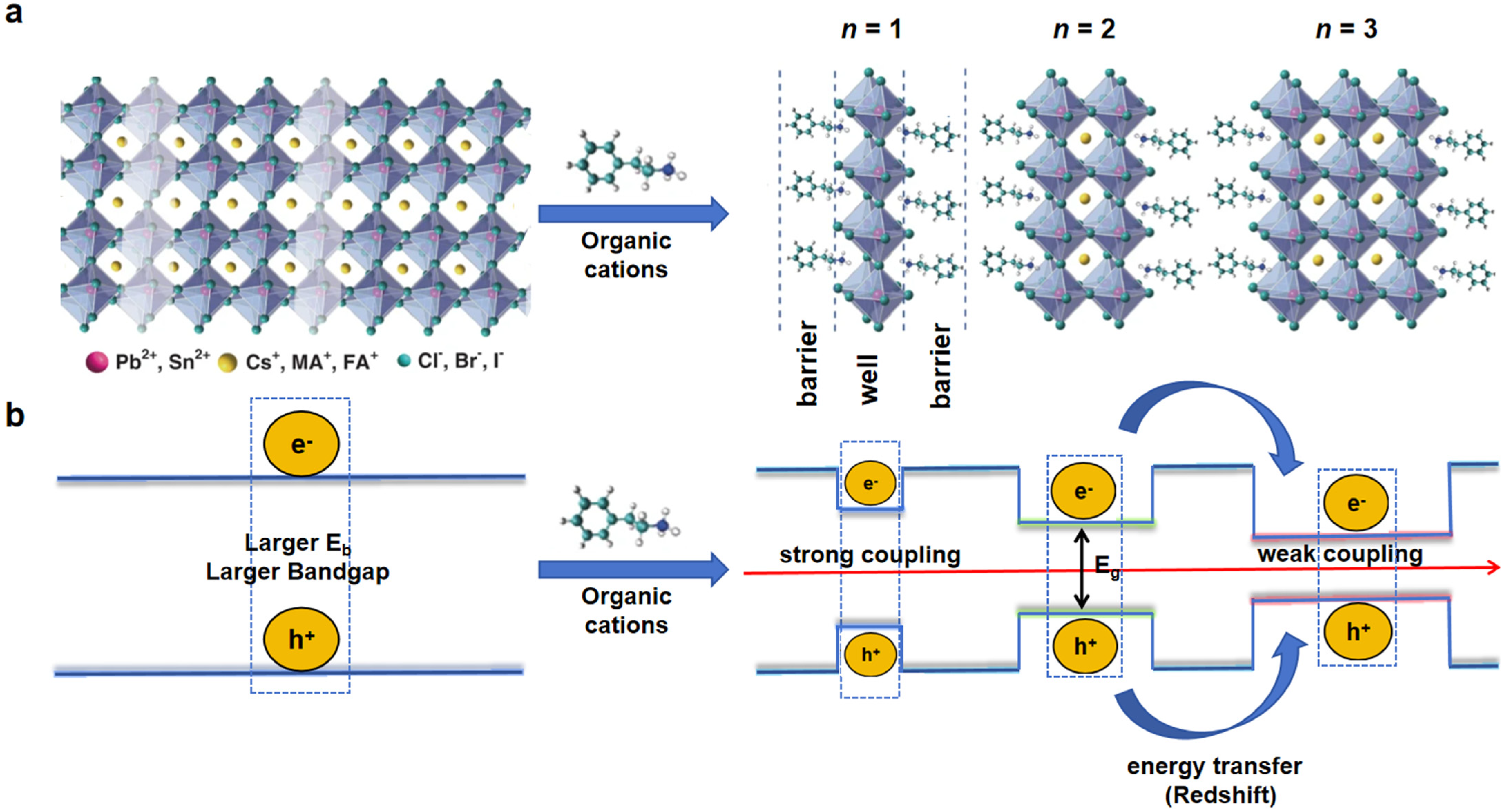

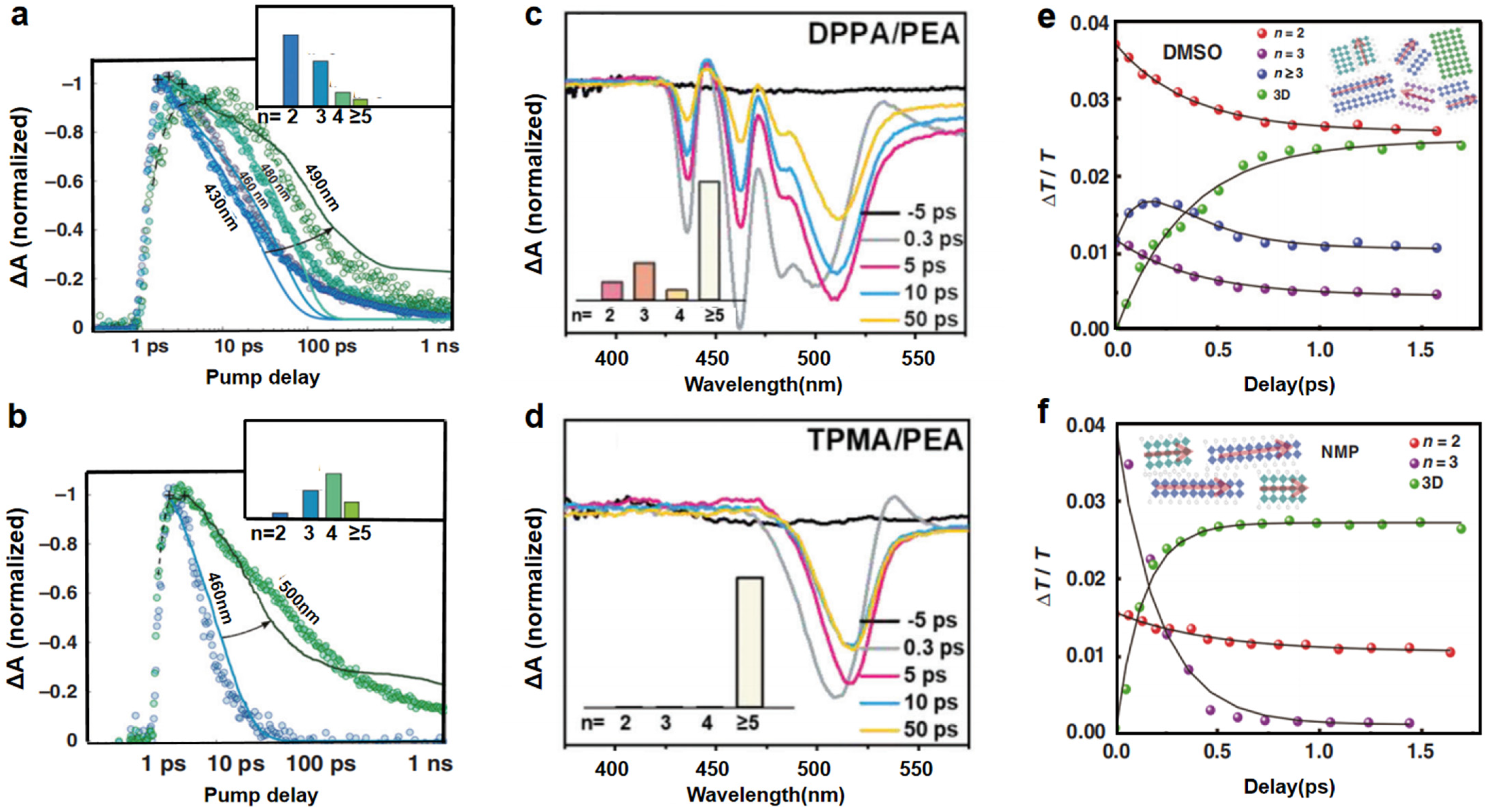
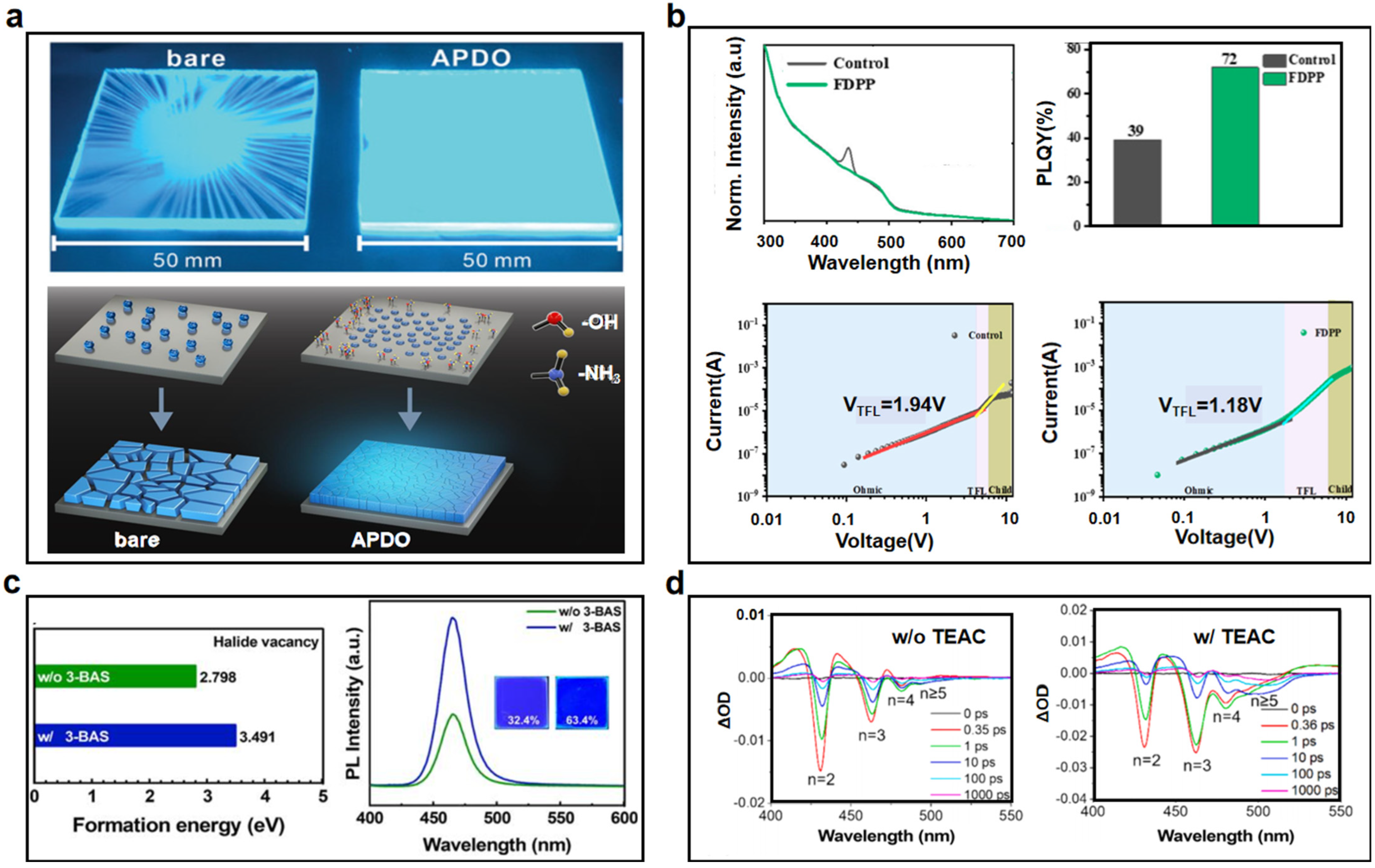
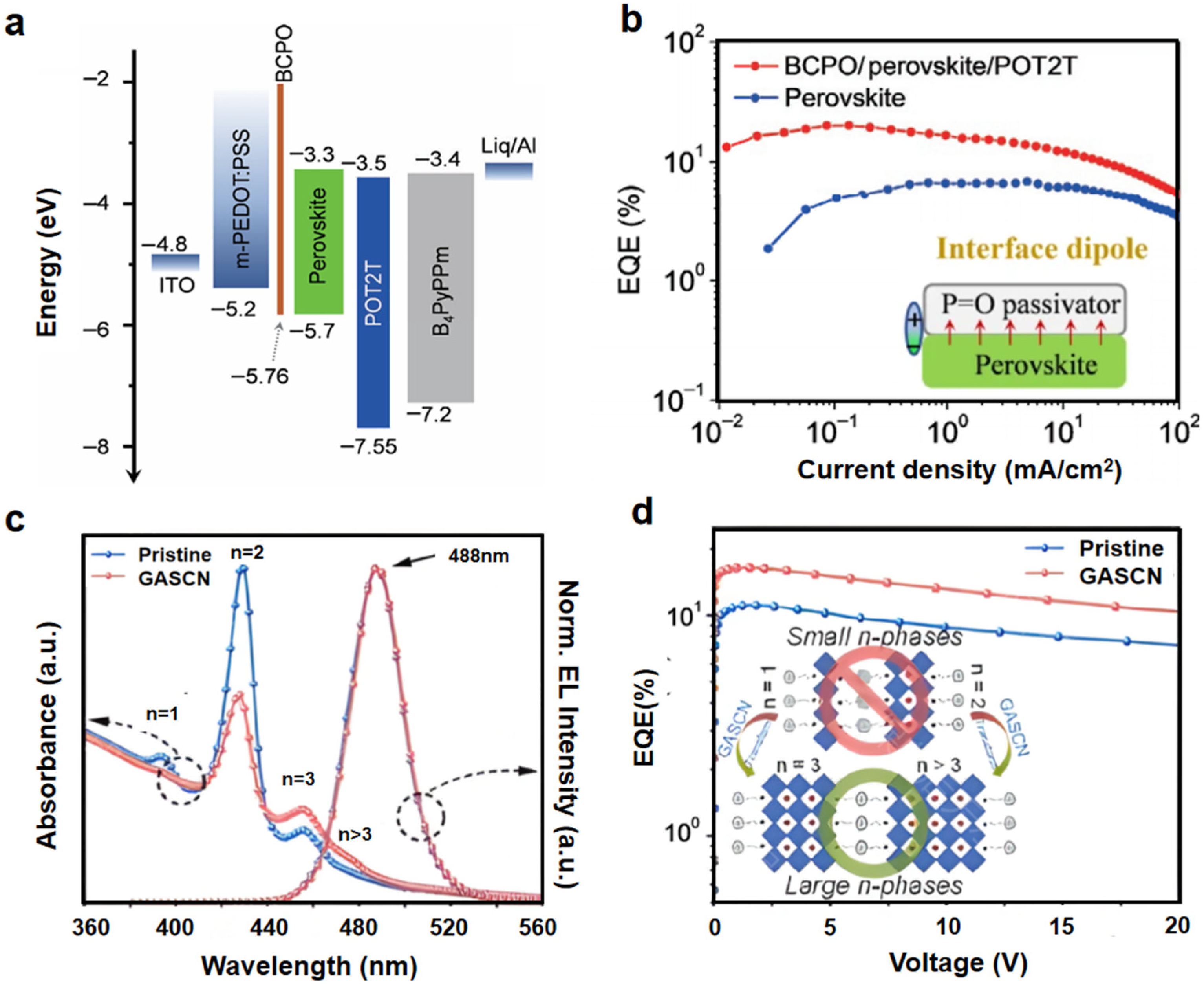

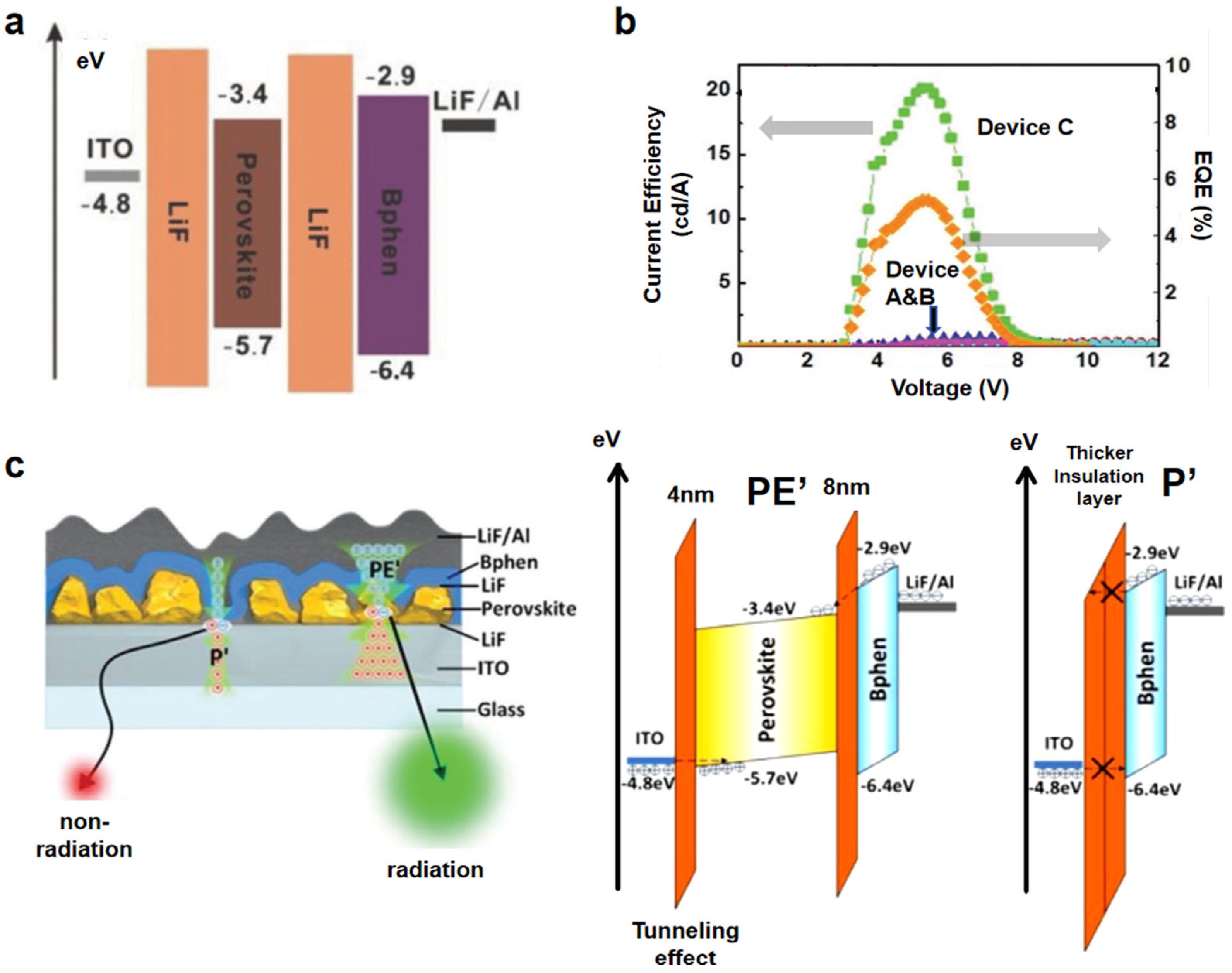
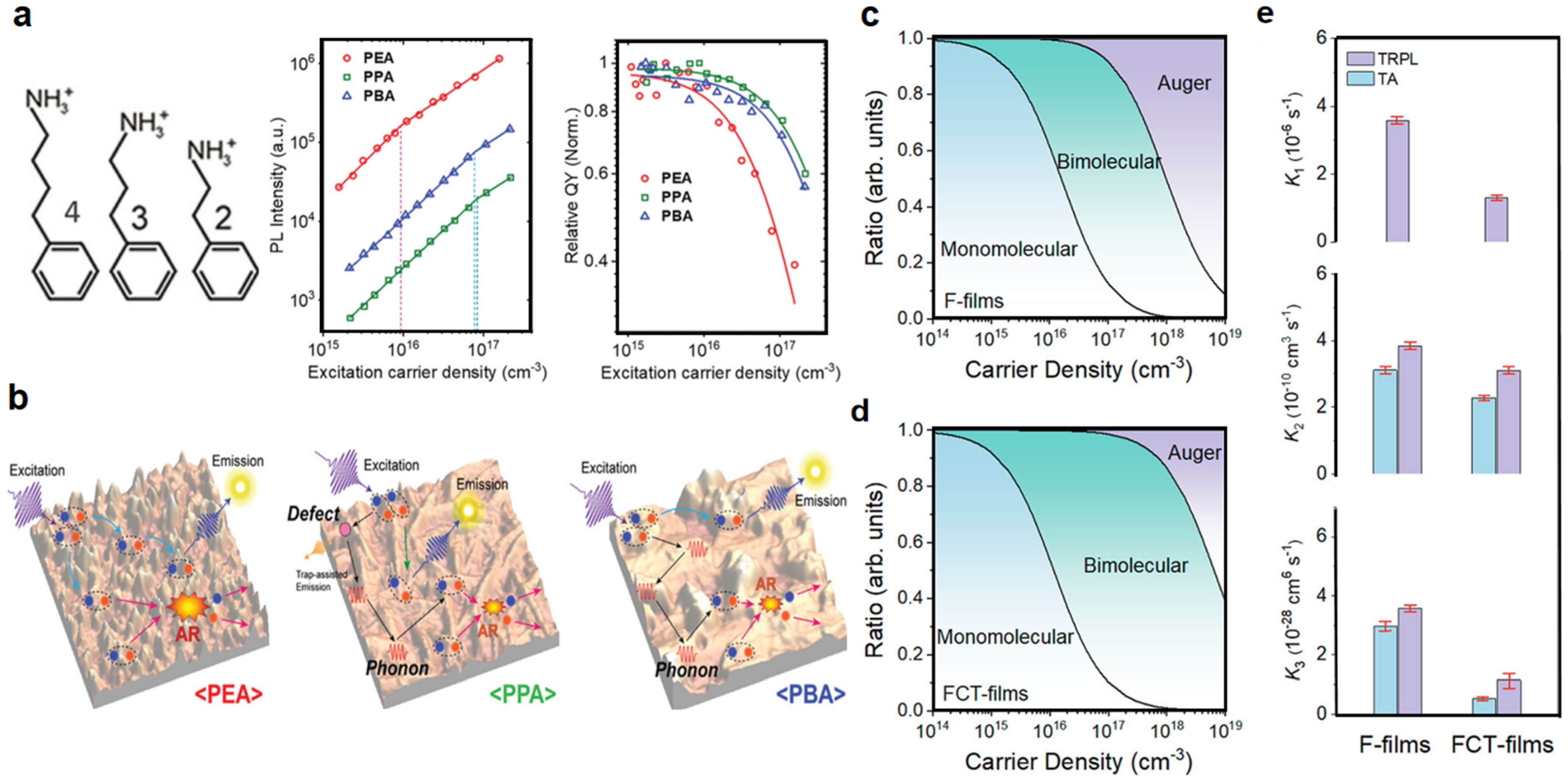
Disclaimer/Publisher’s Note: The statements, opinions and data contained in all publications are solely those of the individual author(s) and contributor(s) and not of MDPI and/or the editor(s). MDPI and/or the editor(s) disclaim responsibility for any injury to people or property resulting from any ideas, methods, instructions or products referred to in the content. |
© 2025 by the authors. Licensee MDPI, Basel, Switzerland. This article is an open access article distributed under the terms and conditions of the Creative Commons Attribution (CC BY) license (https://creativecommons.org/licenses/by/4.0/).
Share and Cite
Zhu, P.; Yuan, F.; Ali, F.; He, S.; Zhang, S.; Wu, P.; Ma, Q.; Wu, Z. Decoding the Role of Interface Engineering in Energy Transfer: Pathways to Enhanced Efficiency and Stability in Quasi-2D Perovskite Light-Emitting Diodes. Nanomaterials 2025, 15, 592. https://doi.org/10.3390/nano15080592
Zhu P, Yuan F, Ali F, He S, Zhang S, Wu P, Ma Q, Wu Z. Decoding the Role of Interface Engineering in Energy Transfer: Pathways to Enhanced Efficiency and Stability in Quasi-2D Perovskite Light-Emitting Diodes. Nanomaterials. 2025; 15(8):592. https://doi.org/10.3390/nano15080592
Chicago/Turabian StyleZhu, Peichao, Fang Yuan, Fawad Ali, Shuaiqi He, Songting Zhang, Puyang Wu, Qianhao Ma, and Zhaoxin Wu. 2025. "Decoding the Role of Interface Engineering in Energy Transfer: Pathways to Enhanced Efficiency and Stability in Quasi-2D Perovskite Light-Emitting Diodes" Nanomaterials 15, no. 8: 592. https://doi.org/10.3390/nano15080592
APA StyleZhu, P., Yuan, F., Ali, F., He, S., Zhang, S., Wu, P., Ma, Q., & Wu, Z. (2025). Decoding the Role of Interface Engineering in Energy Transfer: Pathways to Enhanced Efficiency and Stability in Quasi-2D Perovskite Light-Emitting Diodes. Nanomaterials, 15(8), 592. https://doi.org/10.3390/nano15080592








